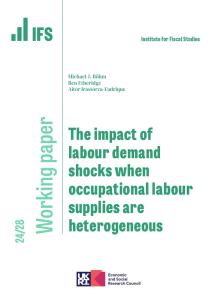The government recently published its response to a consultation on its discount rate methodology for public service pensions. This sounds very technical, and it is. But at its heart, it is asking the question: how should the government value the promise of a pension to public sector employees, when those pensions are only going to be paid out in many years’ time? This is a hugely important, many-multi-billion-pound question. According to the Whole of Government Accounts, public service pensions are the single largest liability on the government balance sheet – bigger than the national debt – running into the trillions. When an NHS hospital, a school or police force hires and employs someone new, that person accrues pension rights over time, which add to this total. The methodology and assumptions used to value those pension promises matter enormously, therefore, for assessments of the government’s long-run fiscal position and sustainability. They are also highly relevant for shaping the choices made by public sector employers around the size of their workforce.
Our aim here is not to provide a judgement on what discount rate methodology ought to be used, but instead to outline the basic contours of the problem and illustrate the sensitivity of the calculations to alternative choices. In its consultation response, the government has decided to continue with its existing methodology, using a discount rate based on the expected long-run growth rate of GDP. But despite the unchanged methodology, the discount rate itself has been revised downwards due a downwards revision in the Office for Budget Responsibility (OBR)’s forecasts for the UK’s long-run growth prospects since 2018, when the exercise was last conducted. This continues the trend of the last decade, where ever-poorer growth forecasts have fed through into an ever-lower discount rate. We explain how this change will affect departments and draw out some key implications for public sector pay and spending policy.
The crux of the problem
The majority of public sector pension schemes are unfunded defined benefit schemes. This means that the government promises scheme members a stream of income in retirement, with the income related to a measure of the scheme member’s salary when they were working. These promises are unfunded, meaning that the government does not set aside a ‘fund’ to meet these costs, but instead plans to pay for these promises out of general taxation as they come due, typically decades into the future.
Therefore, hiring an extra public sector employee imposes a cost both on the employer today (who has to pay their salary) and on future taxpayers, who will have to pay for their pension in the future. To ensure that the public sector employer (such as an NHS trust) properly faces the full cost of hiring an extra employee, they have to make employer pension contributions, which are intended to be a reasonable estimate of the present-day cost of the pension promise they are making. The idea is to stop public sector employers hiring too many workers and making excessive pension promises that then place a high burden on future generations of taxpayers.
The key question is: what is a reasonable estimate of the present-day cost of a pension promise for public sector employers? This is where the choice of a discount rate comes in (in this case called the “superannuation contributions adjusted for past experience”, or SCAPE, discount rate).
The importance of the discount rate
In general, people prefer to receive a certain payment amount now rather than in the future. This is not only because of inflation, but also because people can invest money received today and might expect to receive a positive real return. Discounting is therefore used to reduce the value of future payments and express them in present-day terms. The choice of rate used for discounting – the discount rate – can have a large effect on the current value of a given future payment, especially when the payment is a long while away (as is often the case with pensions). For example, discounting a payment of £1,000 in 20 years’ time using a 1% discount rate implies a value of £820 in today’s terms; discounting it using a 5% discount rate instead implies a value of just £377 in today’s terms.
The government, following its consultation, has decided to stick with its existing methodology, whereby public sector pensions are discounted using the expected long-run growth rate of nominal GDP. This choice for the SCAPE rate is seen as providing a fair reflection of the cost of unfunded public sector pension promises, given that they are paid out of future tax revenue. The intuition – as recommended by Lord Hutton’s Independent Public Service Pensions Commission in 2011 – is that if long-run GDP growth is expected to be higher, the size of the future economy and therefore tax base will be larger, making it easier to meet the future costs of pension promises made today. The converse is true if long-run GDP growth is lower.
This choice of rate has a big effect. To illustrate this, take the NHS pension scheme, where in 2021–22 the average employer contribution rate – determined using forecast long-run GDP growth as the discount rate – was 20.6% of pensionable pay. But if one employs an alternative methodology, and instead uses the much lower yield on high quality corporate bonds as the nominal discount rate (1.55%, rather than CPI+2.4% – i.e. more like 4.4% – under the GDP-based approach), that would instead imply an employer contribution of more like 65% of pensionable pay.
It is beyond the scope of this short piece to comment on what the appropriate SCAPE rate should be. Some responses to the government consultation did advocate using index-linked gilt yields, or yields on corporate bonds, as the appropriate discount rate, which would lead to a much lower discount rate and higher employer contributions. Others supported a return to the form of discount rate used before 2011 (known in the jargon as a Social Time Preference Rate), which would in practice mean a higher discount rate and lower employer contribution rates. Putting the relative merits of each approach to one side, the key point is that the choice of methodology can have a big impact on the estimated present-day value of pension promises, which then feeds into the contributions public sector employers are asked to make in respect of their employees’ pensions.
Changes coming down the line
For the past twelve years, after accepting the recommendation of Lord Hutton’s review, the government has consistently based the discount rate (SCAPE rate) on expected future long-run GDP growth. An unchanged methodological approach does not necessarily mean an unchanged discount rate, however: the SCAPE rate has changed significantly due to revisions to forecasts for long-run growth. The 2011 SCAPE discount rate was CPI+3%, but was reduced in 2016 to CPI+2.8% and in 2018 to CPI+2.4%, leading to an increase in employer pension contributions in the public sector.
As the OBR has further revised down its forecast of long-run growth since 2018, this means a lower SCAPE discount rate: the government has announced the new rate will be CPI+1.7%. As a result, employer pension contributions in the public sector will likely rise in April 2024, when changes resulting from the 2020 valuations are implemented. This rise due to a lower discount rate will, however, be somewhat offset by lower than expected life expectancy improvements in recent years (which imply paying public service pensions for current workers for less long than previously expected).
This change will feed through into the costs facing public sector employers: all else being equal, a lower discount rate will mean higher pension contributions – and therefore higher staffing costs – for schools, hospitals, the army, and so on. In recognition of that, the government has“committed to providing funding for increases in employer contribution rates resulting from the 2020 valuations as a consequence of changes to the SCAPE discount rate”. This follows the precedent of 2018, when departments were more-or-less compensated following a similar change (unlike in 2016, when departments other than the NHS were instead told to absorb the additional costs).
There are two important things to note here. The first is that the decision to compensate departments will be fiscally neutral overall: cash budgets for departments (resource departmental expenditure limits, RDEL) will be increased, but this will be offset by lower resource annually managed expenditure (RAME), because higher contributions reduce net spending on public service pensions.
The second thing to note is that this will likely skew the departmental spending numbers at the next spending review. After being compensated for higher pension costs, departments’ cash budgets will be higher. The compensation provided to departments after the last valuation in 2018 added an average of almost £6 billion per year to departmental budgets; the changes and compensation this time around are likely to be greater still. But this extra funding will go towards paying the higher employer pension contributions and so flow back to the Treasury. The ‘real’ resources available to departments – what they can actually buy – will be unchanged. We therefore will need to take this into account when comparing departmental funding over time and assessing the decisions made at the next spending review. Failing to do so risks overstating the extent to which public service funding is meaningfully increasing over the coming years.
The big picture
Stepping back, if we think the economy will be smaller in the future than previously expected, it will be harder to meet promises to pay future pensions. That will mean one or both of a higher cost for future taxpayers (i.e. higher taxes, or lower spending elsewhere) or higher contributions from public sector employees. It therefore seems sensible to reflect that by increasing the cost to public sector employers today of providing these pensions by increasing the contributions they have to make. In some sense, public sector pensions are becoming more “generous”, not because the government is improving the terms of the pension promise, but because we now think it will be costlier for taxpayers to pay the existing promise.
More generally, this issue highlights questions about the appropriate structure of remuneration in the public sector. Remuneration in the public sector is much more skewed towards pension benefits than in the private sector, yet these pension benefits may not be so highly valued by (would-be) public sector employees as take-home pay when deciding which sector to work in. And while public sector pensions are becoming – on paper at least – more generous, the pay of many of those workers is failing to keep pace with inflation. That will only be exacerbated if public sector employees have to pay higher contributions (or taxes) to meet the costs of pension promises in a smaller-than-previously-expected economy.
Some rebalancing of public sector remuneration away from pensions towards take-home pay could help ease issues with recruitment, retention and morale. A cost-neutral starting point for this could be to reduce employee pension contributions in the public sector, alongside a commensurate decrease in pension generosity, as discussed in detail in last year’s IFS Green Budget.










